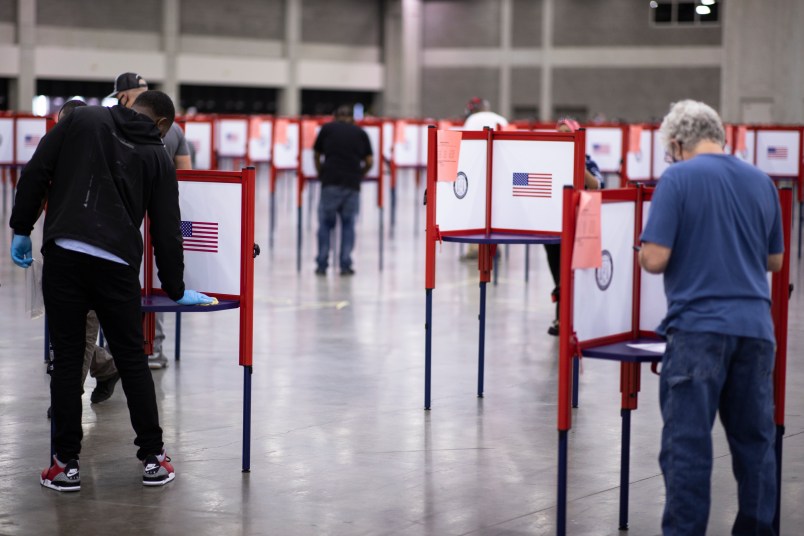In response to voters’ frustration at having to wait a week for their election results during the June primary, Kentucky Governor Andy Beshear (D) and Secretary of State Michael Adams tweaked the rules for the general election.
This time, instead of getting the latitude to wait until the Tuesday after Election Day to announce the final results, county election officials must tally all the votes they have on election night, from absentee and in-person ballots, and publicly report the totals by 11:59 p.m.
The catch? That means some races may look one way on election night, November 3, but change completely by November 10, the next day election officials are required to report their data.
“In my view, it’s not very helpful because we will still be counting mailed ballots for up to a week later,” said Don Blevins, clerk of Fayette County, which includes Lexington.
“So the only difference between this and the primary, effectively, is they are forcing clerks to release partial results. It is likely that local races, for example, could literally be wrong as published on election night,” he continued.
He added that he is “not at all supportive” of the new partial reporting requirement.
Kentucky is allowing ballots postmarked by November 3 to be counted as long as they arrive by 6 p.m. on November 6, meaning that clerks won’t even have a good chunk of mailed-in ballots until three days after the election. Other changes implemented in the Beshear-Adams plan, made under special joint emergency powers to accommodate the COVID-19 pandemic, include expanding the early vote period and letting fear of catching or spreading the virus count as an excuse to vote absentee.
Many experts told TPM that they’re not opposed to the partial reporting; it’s common practice in many parts of the country for the vote to be recorded as ballots are counted instead of waiting until the races have been officially decided. But most of them emphasized the same point — that transparency, or giving voters an idea of how much of the vote is still outstanding, is important, especially given that Kentuckians will be adjusting to this pandemic election on the fly.
“If partial results are going to be reported, it is extremely helpful for election officials to indicate how much of the vote is still outstanding and to remind the public that ballots counted early are not necessarily representative of what the result will be when all of the votes are tabulated,” said Barry Burden, director of the Elections Research Center at the University of Wisconsin.
“A good practice would be for Kentucky to indicate to the best of their knowledge the number of absentee ballots still outstanding — not all of them will be sent back in — and to indicate the source of any votes added to the unofficial tally each day,” added John Fortier, director of the Bipartisan Policy Center’s Democracy Project. “For example, if the day after the election, 1,000 more absentee ballots are counted and 50 provisional ballots, the most transparent systems would make that clear to the public.”
But it’s still to be seen if that level of transparency will be possible for this election, or if counties will even update those election night totals at all before they’re required to on November 10, the Tuesday following Election Day. The Beshear-Adams plan was only approved by the state Board of Elections about two weeks ago, leaving election officials still scrambling to figure out the nuts and bolts of implementing the new measures.
Figuring out the number of absentee ballots still to be counted comes with its own challenges this year. The election is expected to be unusual in that it’ll likely have high turnout — “we are at 24,000 [ballot] requests already,” said Blevins — and the rules governing an acceptable ballot have been relaxed, so fewer will likely be tossed.
“This is something we are looking at, as this is the first time it has been done this way,” Jared Dearing, executive director of the state BOE, told TPM when asked whether it would be possible to give voters an idea of the outstanding vote. “As of now I would think that some of the numbers would be available. But it may be misleading to state that there is an outstanding vote of X, as not all absentee ballots that are requested are returned.”
It’s also yet to be seen whether overwhelmed election workers would have the bandwidth to specify how many votes are yet to be counted in certain races or counties. Blevins postulated that the BOE could ultimately compare the totals counties have reported with ballots that haven’t been returned statewide, giving a broad idea of how much of the vote is yet to be counted.
Without those transparency benchmarks, voters may not have the context to realize that the partial election-night results are just that — partial, preliminary, likely to change in the days following.
“I do think there’s a risk that announcing partial returns could cause confusion if the vote totals change,” Josh Douglas, distinguished professor at the University of Kentucky Rosenberg College of Law, told TPM. “And we also know that in other states with a lot of mail-in ballots, vote totals often do change in favor of Democratic candidates — the ‘blue shift.’”
Such a shift could cast doubt on the ultimate result of the election — particularly in an environment where President Donald Trump has been campaigning to undermine the validity of voting by mail. While Kentucky is unlikely to be a battleground for the Presidential contest, races like Senate Majority Leader Mitch McConnell’s (R-KY) will likely draw national attention.
Shifting from reporting full results only when they were ready, as Kentucky did in the primary, to partial results in the general “is likely to confuse and frustrate the public,” said Burden. “Enough procedures are in flux this year that consistency in reporting methods would be a helpful antidote.”



